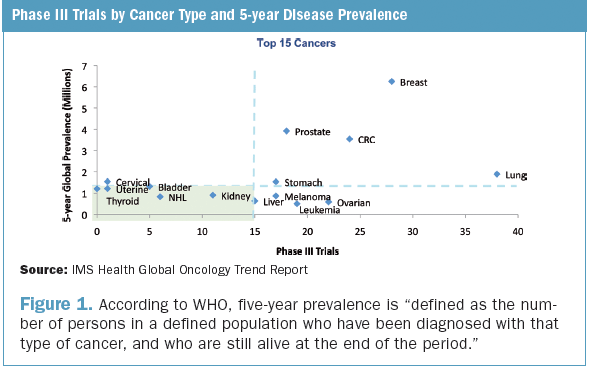Five-Year Disease Prevalence Only One Driver of R&D Investment
The five-year figure doesn't always determine which cancer types are most commonly being studied in late-phase trials.
Five-year disease prevalence is certainly a factor-but apparently not the only one-determining which cancer types are most commonly being studied in late-phase clinical trials. IMS Health's analysis of the distribution of Phase III trials reveals that, as would be expected, cancers with higher five-year disease prevalence are the subject of more late-phase trials. But there are exceptions (see Figure 1).

The first is lung cancer. It is the clear leader in terms of the volume of Phase III trials, yet has about the same five-year prevalence as cervical and stomach cancers, both of which are involved in dramatically fewer trials. This may be tied to the fact that the molecular targets in non-small cell lung cancer have been long-since identified and extensively studied. The second exception is ovarian cancer, which has one of the lowest five-year prevalence rates, but is being heavily studied in Phase III trials due to the fact that several genetic mutations can affect the outcome for ovarian cancer patients.
Thus, a low five-year disease prevalence does not always inhibit research investment, provided that the genetic target can be identified in patients. - IMS Health

Unifying Industry to Better Understand GCP Guidance
May 7th 2025In this episode of the Applied Clinical Trials Podcast, David Nickerson, head of clinical quality management at EMD Serono; and Arlene Lee, director of product management, data quality & risk management solutions at Medidata, discuss the newest ICH E6(R3) GCP guidelines as well as how TransCelerate and ACRO have partnered to help stakeholders better acclimate to these guidelines.
Gilead Shares Final Data from Phase III MYR301 Trial of Bulevirtide in Chronic Hepatitis Delta Virus
May 7th 2025Long-term results from the study show 90% of patients with chronic HDV who achieved undetectable HDV RNA at 96 weeks of treatment remained undetectable for nearly 2 years post-treatment.